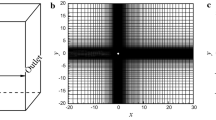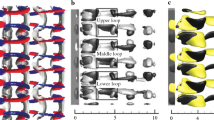Abstract
The early stage of a boundary layer bypass transition induced by the direct impingement of a circular cylinder wake is experimentally investigated in water tunnel, with the primary interest in both the evolution of coherent structures and their effects on the disturbance growth inside the boundary layer. It is found that spanwise vortices with small scale first form in the near-wall region around the leading-edge, which are either the residual of the wake rollers cut by the leading-edge or the high-order structures induced by the wake rollers. The formation of these spanwise vortices leads to the first rapid disturbance growth inside the boundary layer. On the other hand, streamwise vortices, which result from the impingement of longitudinal braids onto the leading-edge, are also observed inside the boundary layer. They lead to the three dimensional destabilization and the subsequent dispersion of spanwise vortices, and soon become the most dominant coherent structures inside the transitional boundary layer. It is suggested that the formation and evolution of these streamwise vortices contribute to the secondary disturbance growth stage and thus promote the completion of the transition process. The difference between the present transition scenario triggered by direct wake impingement and that by indirect wake-vortex inducement is further discussed.
Similar content being viewed by others
References
Morkovin M V. On the Many Faces of Transition. In: Wells G S, ed. Viscous Drag Reduction. New York: Plenum Press, 1969
Harvey J K, Perry F J. Flowfield produced by trailing vortices in the vicinity of the ground. AIAA J, 1971, 9: 1659–1660
Savill A M, Zhou M D. Wake/boundary layer and wake/wake interactions: Smoke flow visualization and modelling. In: Second Asian Congress of Fluid Mechanics, 1983
Wang S F, Wang J J, Zhan J X. Characteristics of low-speed streaks in near-wall turbulence as disturbed by cylinder wakes (in Chinese). Experim Measurem Fluid Mech, 2003, 17: 45–48
Jiang N, Li Y L. Experimental study on coherent structures in wall turbulence interacting with a circular cylinder wake (in Chinese). J Experim Fluid Mech, 2007, 21: 8–13
Kyriakides N K, Kastrinakis E G, Nychas S G, et al. Aspects of flow structure during a cylinder wake-induced laminar/turbulent transition. AIAA J, 1999, 37: 1197–1205
Ovchinnikov V, Piomelli U, Choudhari M M. Numerical simulations of boundary-layer transition induced by a cylinder wake. J Fluid Mech, 2006, 547: 413–441
Pan C, Wang J J, Zhang P F, et al. Coherent structures in bypass transition induced by a cylinder wake. J Fluid Mech, 2008, 603: 367–389
Wu X H, Jacobs R G, Hunt J C R, et al. Simulation of boundary layer transition induced by periodically passing wakes. J Fluid Mech, 1999, 398: 109–153
Wu X H, Durbin P A. Evidence of longitudinal cortices evolved from distorted wakes in a turbine passage. J Fluid Mech, 2001, 446: 199–228
Durbin P A, Wu X H. Transition beneath vortical disturbances. Annu Rev Fluid Mech, 2007, 39: 107–128
Ersoy S, Walker J D A. The boundary layer due to a three-dimension vortex loop. J Fluid Mech, 1987, 185: 569–598
Walker J D A, Smith C R, Cerra A W, et al. The inpact of a vortex on a wall. J Fluid Mech, 1987, 181: 99–140
Peridier V J, Smith F T, Walker J D A. Vortex-induced boundary-layer separation. Part II. Unsteady interacting boundary-layer theory. J Fluid Mech, 1991, 232: 133–165
Chu C C, Falco R. E. Vortex ring/viscous wall layer interaction model of the turbulence. Exp Fluids, 1988, 6: 305–315
Liu W, Domaradzki J A. Direct numerical simulation of transition to turbulence in Görtler flow. J Fluid Mech, 1993, 246: 267–299
Pan C, Wang J J. Progress in bypass transition induced by free-stream disturbance (in Chinese). Adv Mech, 2011, 41: 668–685
Goldstein M E, Wundrow D W. On the environmental realizability of algebraically growing disturbances and their relation to Klebanoff modes. Theor Comput Fluid Dyn, 1998, 10: 171–186
Goldstein M E, Wundrow D W. Effect on a laminar boundary layer of small-amplitude streamwise vorticity in the upstream flow. J Fluid Mech, 2001, 426: 229–262
Williamson C H K. Vortex dynamics in the cylinder wake. Annu Rev Fluid Mech, 1996, 28: 477–539
Huang J F, Zhou Y, Zhou T. Three-dimensional wake structure measurement using a modified PIV technique. Exp Fluids, 2006, 40: 884–896
Scarano F, Poelma C. Three-dimensional vorticity patterns of cylinder wakes. Exp Fluids, 2009, 47: 69–83
Zhou H, Zhao G F. Hydrodynamic Stability (in Chinese). Beijing: National Defense Industry Press, 2004
Author information
Authors and Affiliations
Corresponding author
Rights and permissions
About this article
Cite this article
Wu, J., Pan, C. & Li, T. Experimental investigation on coherent structures at early stage of boundary layer bypass transition induced by wake impingement. Sci. China Technol. Sci. 55, 2981–2989 (2012). https://doi.org/10.1007/s11431-012-4976-5
Received:
Accepted:
Published:
Issue Date:
DOI: https://doi.org/10.1007/s11431-012-4976-5




